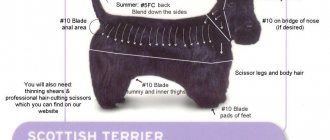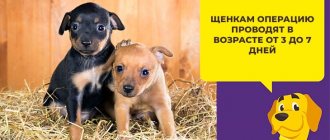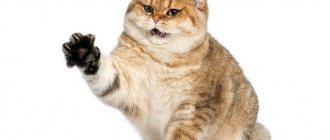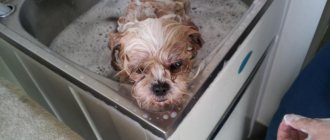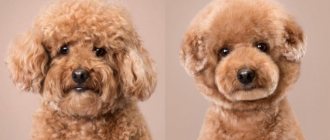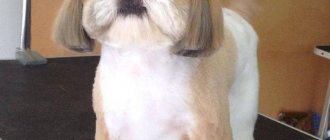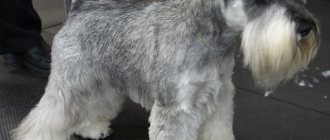How to trim/shave your Black Russian Terrier yourself.
Spring-summer, heat, your blackie has grown over the winter and you understand that it’s time to trim your pet’s hair. On this page I will show and briefly tell you how to shave a Black Russian Terrier so that the dog looks beautiful and is pleasing to the eye. Necessary tools.
- Comb .
- The scissors are long, well sharpened. You can order and buy on AliExpress, preferably no shorter than 8 inches, their cost is about 2 thousand rubles. The steel of these scissors is soft, the scissors become dull rather quickly, but they are quite suitable for home haircuts.
- Shaving machine. You can read about choosing a machine - Caring for a black terrier
- Machine knives. It is best if you have 3 knives and a knife from 5 mm in your set
Where to begin .
Rinse the blackberry. This procedure is simply necessary if you want to save machine knives and scissors. Shaving and cutting dirty wool “kills” your tools and the desire to save time and effort will cost you at least the price of clipper knives. And they are now very expensive.
Briefly about washing and drying. It is necessary to wash the black terrier's fur with shampoo until the soapy water that is washed off is white or clear. Those. lathered, “massaged” the fur, rinsed it off and looked at how clean the wash was. If the shampoo being washed off is gray or even black, lather it again. It is advisable to carry out the first wash with shampoo, which has super-cleaning properties (see the name - this is “deep cleansing”, peeling shampoo, for oily hair, etc.). And, in my opinion, it doesn’t matter whether this shampoo is for dogs or for people. The statement about different PH is a myth, a fairy tale, pure marketing. I once measured the pH of shampoos and conditioners for dogs and people with test strips - there was practically no difference. AND ! You will dilute the shampoo with water, at least in proportions of 1/3. Is it logical that the advertised PH is leveled by water? Logical.
A little secret. To wet a dog, 3 liters of water is enough. Don't believe me? check . Take old used shampoo bottles (I use liter plastic bottles from Domestos, their spout is at an angle - it’s more convenient), pour warm water, add 1-2-3 tablespoons of super-cleansing shampoo, mix, carefully turning the bottle over. You can dilute the shampoo in a bucket or basin and apply this solution with a sponge. The shampoo opens the hair scales, so the hair stops repelling water. For me, 2 liters of solution is usually enough.
Washed? Did you rinse well? Be sure to rinse off the shampoo very well. Otherwise, the coat will be dull, irritation and dandruff may appear. Rinse it off, don't be lazy.
Dry the fur with towels and comb the dog. Yes, wet and comb - it’s easier to untangle the tangles. We combed it, now we dry it. Dry those areas that you won’t shave with a hairdryer while combing, this way the dog will dry faster and, having lost some time and effort in this procedure, you will save in the future, this way the dog’s coat will tangle less and will look beautiful for a longer time, yes and cut it better.
Shaving scheme :
Approximate diagram
We take a machine with a knife of 5 or higher. And we shave according to the pattern.
Points on the diagram:
- 1 in the picture - the place where the paw bends.
- 2 elbow or slightly higher.
- 3 the point above the groin is the top of the curved line belly - thigh. In the photo this point is shifted towards the tail and raised very high. It can be lowered and moved towards the head. If in doubt, take the groin fold and measure up about 5 cm.
- 4 bending point of the hind leg. You can also vary - shave above or below this point.
Shave your back while pulling back the skin. If you want the coat to be a little longer, shave according to the growth of the coat, it may not turn out very carefully, since the hair will not be cut evenly, but after a couple of weeks you will not notice this. If you shave against the grain, the cut will be more even. Shaved your back? Now we use a machine to mark the transition lines from shaved to long wool (drawn in the photo). Walk along these visually outlined lines with a machine, even if it is somewhat uneven, you can trim it later. According to the diagram, there are two lines on the front paw - choose any one you like best. If along a bright line, it will be somewhat more difficult to align later, but the dog, in my opinion, will look more stylish. If the dog is very overgrown and it is not very convenient to mark a line with a clipper, in this case take scissors and cut the hair from the elbow, repeating the bottom line.
Next, shave the sides, front, and back to the designated lines/points. In the front, you can leave the long hair in a triangle or just a straight strip from the chest bone down. Or you can shave it completely, then it’s worth shaving the skirt too, i.e. You don’t have to mark line 2-3, but shave the entire body.
Shave your ears from the outside and inside. Draw a line down from the base of your ear and shave your neck along it. I shave deeper, closer to the eyes, i.e. I retreat 1-2 cm from the base of the ear - this way the ear “breathes” better.
We shave the dog's rear (backside). It's simple - shave everything down to point 4. Shave the back legs and the inside along line 3-4.
Next, at first glance, the most difficult thing is the decoration and transition from shaved to long wool. Frame. Use a machine to straighten the intended transition lines. Next, comb the long hair on the body, style it, combing from top to bottom and, repeating the line of the shaved body, cut it. There is no need to take a piece of wool and trim it, the wool will still look like that - in shreds. I'll post a photo or video later.
Legs . Trim your nails. Shave or trim the fur between the paw pads. Comb the bottom of the paw, laying everything down. Next, grab the paw near the very pads, grabbing the fur, lift the paw and cut off everything that extends beyond the contour of the paw. (there will also be a photo explanation). Place the dog, front paws d.b. parallel to each other, trim the bottom of the paws, aligning them in a circle.
The upper part of the front paws (decoration). Comb the decorating hair, then use a slicker brush to lift the hair up. Cut to the length you like best, but try to make even columns. If you combed it poorly during drying, it’s unlikely to work out exactly, and if there are tangles left, then it will be a complete mess.
Hind legs . Comb the decorating hair from top to bottom and cut it with scissors, following the contour of the thigh and lower leg to the metatarsus. The metatarsus can be shaped in the same way as the front legs - in a column, of course, taking into account the hair on the lower leg. Photos (probably video) will be posted a little later.
If your blackie is shaving for the first time, then to avoid scratching until it becomes scabby, wash the dog, dry it and lubricate the shaved area with aftershave cream (I use “Rescuer” balm for these purposes).
the dog is shaved
Good luck!
see also
Grooming of the Black Russian Terrier. Diagrams and explanations.
Wheaten Terrier Grooming
It is believed that the blood of this terrier flows in the veins of the Kerry Blue and Irish Terriers. Kerry Blue litters sometimes contain wheat-colored puppies. This stately, medium-sized, compact terrier, with a soft, almost velvety-to-the-touch wheat-colored coat, naturally wavy or flowing in soft curls, is intended for indoor use only. He is very capable and has hunting abilities, but his skin is prone to eczema. Daily care of the coat of a wheaten terrier is simple. It consists of normal hygiene procedures, examining the dog for external parasites and brushing, which it must be accustomed to from puppyhood. For daily brushing, it is better not to use wire or plastic brushes. The hair fluffs up when using these tools - a quality that should be avoided. It is better if it is an infrequent metal comb with long, large teeth (the kind used to comb poodles). When combing, sort out the matted hair; the hair of a properly combed dog will be dense, non-sticking, non-electrified - the raised hair should very gently return to its original position. It is advisable to occasionally moisten the feet, groin area, stomach, inner and outer sides of the thighs with water and sprinkle with boric acid powder, since the dog often bites these places, and under the influence of the saliva that remains here, a rusty sheen may appear, which will greatly damage its appearance. mind. Wash Wheaten Terriers as needed, always with a good mild neutral shampoo followed by conditioner.
Drying is also an important procedure. The hair dryer jet should not be very hot, and the teeth of the comb with which you will pick up strands of hair should not be sharp, so as not to cause damage to delicate skin. To dry your hair from root to tip, picking up a strand, it should be opened outward, as it were. If you do this with precise, quick movements, lightly shaking each strand and exposing it from all sides to the stream of air from a hairdryer, you can protect your skin from irritation. And one more piece of advice: wash your dog no later than three days before the exhibition - the coat should restore its normal fatty lubricant and not become fluffy. In Great Britain and Ireland, dogs are entered into the ring in their natural form. Only lightly “clean up” the ears with thinning scissors on both sides to 2/3 of their length from the tip and trim the hair a little along the edges, giving the tail a conical shape.
You can also trim the fur on the chest and neck ridge a little to just give it a neater appearance. In the Scandinavian countries, Japan, Austria, the USA and Canada, the Soft Coated Wheaten Terrier appears trimmed at shows. The haircut highlights the characteristic features of a given breed, those features of its external appearance that give it a unique flavor. And, as in the case of the Kerry Blue Terrier, interest in this breed has increased significantly thanks to trimming. Before grooming, the dog should be thoroughly washed as usual, but instead of conditioner, you will need a fairly large amount of balm with lanolin. The wool is also dried according to all the rules, but for combing, use a brush with metal teeth for the sides, beard and fringes on the limbs, and a soft rubber one for the back, skull and neck. When drying, pull the hair slightly. Get the dog to shake vigorously several times - the hair will take its usual position. Grooming and trimming of a Wheaten Terrier is carried out on a cutting table; it will be more convenient (it is better if he stands in front of a mirror, like in a hairdresser). Lightly stroke the Wheaten Terrier's coat on all sides. Grooming a Wheaten Terrier is carried out as follows.
Hairdressing salon for dogs and cats "Laicats" offers services - haircut, trimming, washing, blow-drying, spa treatments, grooming, wheaten terrier.
Proper care after haircut
The Lha Apso dog breed does not prefer long walks. Because these dogs are considered pets. For proper care, after the Lhasa Apso has been groomed, it is necessary to bathe the dog at least once a week. It is better to use mild shampoos, and after washing, dry with a hairdryer, constantly combing the coat. This process will not only return the dog to its original appearance, but will also give a refined appearance to its coat. Since the Apso's coat is quite thick, the dog needs to be brushed every day. Also, you should not allow a large clot of hair.
Basically, for Lhasa Apso hairstyles, experienced hairdressers and hairdressers use:
- thinning scissors;
- regular scissors;
- trimming tools.
Hairdressers try to protect the exquisite appearance of a dog's coat by creating different hairstyles. For example, they try to shorten long and thick fur. Because this procedure will ensure easy movement of the dog. Therefore, grooming the Lhasa is a must for proper care of a purebred dog.
Description of the Lhasa Apso breed
This dog is not large in size, but at the same time it amazes with its courage and energy. This is an excellent guard who, with his barking, can warn his owners of impending danger, as his ancestors did in Tibet, warning of an approaching earthquake or avalanche. The description of the Lhasa Apso indicates the presence of acute hearing and a loud voice. For all his sociability and sociability, he is an assertive and stubborn dog, distrustful of strangers, but at the same time obedient and easy to train, loyal to children.
History of the Lhasa Apso breed
The breed is more than 2 thousand years old and the first to breed it were Tibetan monks. The Lhasa Apso dog still protects Buddhist temples and Tibetan homes to this day. It is no coincidence that the name of the breed, because Lhasa is the capital of Tibet, and “apso” translated from Tibetan means “bearded.” According to one version, “lhasa apso” means “goat-like.” Experts believe that even before its direct duties as a guard, the dog performed the role of a shepherd, watching over domestic goats.
The breed came to Europe thanks to the British scout Frederick Bailey. After completing his mission in Turkestan, he returned home with his dog. Since then, the Lhasa Apso has spread throughout the world and has earned the love of many breeders. The dog is incredibly cute and has an attractive appearance and luxurious long hair that requires proper care.
Lhasa Apso breed standard
The dog has a proportional build and a somewhat elongated shape. Lhasa Apso weighs around 6-7 kg. Its main feature is strong, long, heavy and coarse hair, well developed on the tail, paws and muzzle. Often it falls so far on the forehead that it completely covers the dog's eyes. The ears are drooping and also densely covered with hair. While moving, which is free and easy, the dog throws its luxurious tail over its back. The color can have various shades, from sand to black. Sometimes there is a mixture of different patterns.
Lhasa Apso and Shih Tzu - differences
According to genetic studies, the Lhasa Apso gave rise to such a breed as the Shih Tzu. The latter is not much different from it. Lhasa Apso and Shih Tzu have multiple comparisons. They have a lot in common both in appearance and character. The homeland of the Shih Tzu is also Tibet, from where the dog first came to China, and then was taken to Europe. The breeders were captivated by this small but brave dog - alert, independent and very affectionate. It is also densely covered with long hair and has a beard and mustache.
